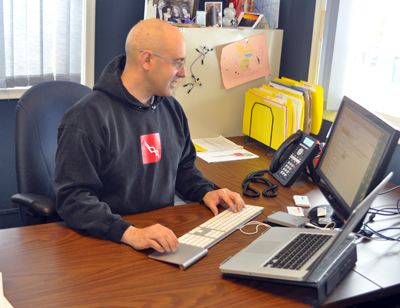
By David F. Rooney
The Canadian Avalanche Centre is planning for the near future through a Request for Proposals it hopes will help them transform the current centre into a Centre of Excellence in Avalanche Safety and Education.
“The root problem is we’re out of room,” says CAC Executive Director Ian Tomm.
“When we bought this place in 2004 we never dreamed of the day we would have so many staff we’d be out of room, but here we are now in 2012 and we’re putting two people into offices that really should house only one and that limits what we can do with the maturation of our programs.”

The CAC provides national avalanche forecasting, primarily for BC and Alberta, but also in the Yukon, Northwest Territories, Newfoundland and Quebec. It does have a satellite office in Vancouver and is considering one for Fernie and the Elk Valley.
Besides forecasting, it also provides avalanche safety training, a variety of other education programs for skiers, snowmobilers and others and develops tools for that help people assess the risk of avalanches in the backcountry.
“We’re getting more and more foot traffic in here because Revelstoke is a big destination for snowmobiling, backcountry skiing and resort skiing,” Tomm said. “Okay, yeah, we have a front office, a reception space and so on. But we’d like to do more.”
He said the CAC needs classroom space of its own for certain kinds of educational programs — even in the summer months.
“The last need is in our basement we have over 100 years of what we would call national avalanche artifacts,” Tomm said. “It’s actually got a name. We call it the Art Twomey Memorial Library. We have an amazing wealth of avalanche information we would like to make available to the public
“So here we are with these multiple needs… do we renovate and go up a floor? Do we get a new building?”
Tomm said he spoke with Community Executive Director Alan Mason and Lynda Lafleur, the Columbia Basin Trust’s Nakusp-based Community Liaison.
“In almost every other country around the world that deals with avalanches everything is done by government… except here,” he said. “In Canada it’s all done by a non-profit organization.”
The CAC receives a little over $1 million from the governments of BC, Alberta and Canada as well as other, private or business sources. It has a core staff complement of about 30 people and another 70 contract staff. Click here to read its 2010-2011 Annual Report.
Tomm said the CBT is attempting to encourage the establishment of Centres of Excellence throughout the Columbia Basin and this one proposal surely is a “natural.” The Basin is, of course, avalanche country and the CAC’s desire to set up a national and international Centre of Excellence is, in part, a result of those conversations.
The CAC also has a significant relationship with the University of Calgary and is developing a new with Simon Fraser University.
“We’ve always had researchers coming through here but we’re so jammed it’s like all we can offer them is a place on the floor,” he said.
“I say that in jest but we need to do something about this. This the center of avalanche forecasting and research in Canada.”
Hence a nascent plan to build the CAC into a true Centre of Excellence.
If successful, this could have long-tem ramifications for the town of Revelstoke. For more than a decade community leaders have talks about the desirability of establishing some kind of port-secondary research centre in Revelstoke. Unfortunately, while just about everyone supports the idea no one has been able to make it happen. This could be the idea that produces actual results. Not just in terms of achieving the CAC’s vision but in its ability to attract other enterprises, thereby further diversifying our local economy.



